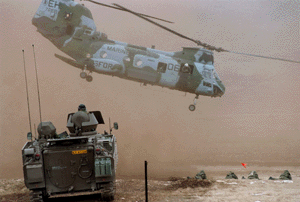Noise and the dispersion of troops during small unit combat make voice communication difficult. S.L.A. Marshall wrote about this in his famous book "Men Against Fire," where he noted that hand signals are helpful, but only if infantrymen pay attention. All leaders need a small bullhorn to amplify their voice when necessary. Hand-held bullhorns have been around for years. Modern electronics and new small batteries should permit bullhorns the size of a coke can, with a strap so it can be worn around the neck. This can extend the range of the human voice from 50 meters to 200 meters, allowing platoon leaders to communicate with any member of his platoon during combat. During a firefight it is difficult to hear someone shouting just a meter away.
 For example, a grunt may be pinned down by enemy fire in an open field. The
platoon leader wants him to stay put until enemy fire is suppressed but
is unable to communicate this message 40 meters away. The grunt makes a foolish
dash to rejoin his unit and is gunned down. Platoon leaders need a small
bullhorn
to control grunts with basic commands such as: Move
Forward! Stay there! Fall back! Minefield! Cease fire!
In addition, leaders can better
control machine gun fires and other crew-served weapons with bullhorns. Finally,
normal voice communications are nearly impossible when helicopters or large diesels engines
are nearby.
For example, a grunt may be pinned down by enemy fire in an open field. The
platoon leader wants him to stay put until enemy fire is suppressed but
is unable to communicate this message 40 meters away. The grunt makes a foolish
dash to rejoin his unit and is gunned down. Platoon leaders need a small
bullhorn
to control grunts with basic commands such as: Move
Forward! Stay there! Fall back! Minefield! Cease fire!
In addition, leaders can better
control machine gun fires and other crew-served weapons with bullhorns. Finally,
normal voice communications are nearly impossible when helicopters or large diesels engines
are nearby.
The great book "Blackhawk Down" about the disastrous 1993 Ranger raid in Somalia provides dozens of examples where simple bullhorns would have helped the "high-tech" Rangers. They learned that when pinned down in a crowded city, small teams easily become confused and separated, and cannot determine each others location even when they communicate with radios. This makes it difficult to coordinate air support and prevent accidental friendly fire. A bullhorn allows someone to broadcast: WE'RE HERE, WHERE ARE YOU? In one case, Rangers could have learned that another team they were talking to on the radio was inches away, on the other side of a wall. Several times, they saw a rescue force drive by a block away but couldn't get their attention due to the intense small arms fire. Someone with a bullhorn could have broadcast: WE'RE OVER HERE YOU IDIOTS!
 Bullhorns
also provide an emergency method
for company level officers to communicate in cases when radios malfunction or
are subject to jamming. Bullhorns can avoid problems when friendly units
are encountered at a distance with a loud: HALT, WHO GOES THERE! Soldiers in encampments and airfields suffer from confusion during surprise attacks since
gunfire only tells them that "something" is happening. If guards
have bullhorns, they can immediately announce: Battle stations, Battle
stations, infiltrators near the river.
Bullhorns
also provide an emergency method
for company level officers to communicate in cases when radios malfunction or
are subject to jamming. Bullhorns can avoid problems when friendly units
are encountered at a distance with a loud: HALT, WHO GOES THERE! Soldiers in encampments and airfields suffer from confusion during surprise attacks since
gunfire only tells them that "something" is happening. If guards
have bullhorns, they can immediately announce: Battle stations, Battle
stations, infiltrators near the river.
One drawback is that enemy forces can hear amplified shouting. However, it is unlikely they understand English or the context of the message. On the other hand, hearing English voices may frighten enemy soldiers. A bullhorn is valuable to encourage enemy surrenders and warn civilians to stay away. American GIs shot up dozens of approaching civilian vehicles in Iraq fearing they were car bombs because they were unable to tell the driver to halt.
The primary way for infantrymen to communicate with tanks, armored vehicles, trucks, and helicopters on the ground is to run over and shout into ears. Bullhorns help, especially in convoys and landing zones, and prove valuable in coordinating operations at seaports, construction sites, and airfields. Likewise, every combat vehicle and helicopter must have a loudspeaker system like those used by police cars. Loud speakers are considered essential at every military rifle range. It is amazing they are not used in combat.
©2015 www.G2mil.com